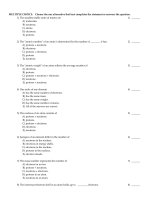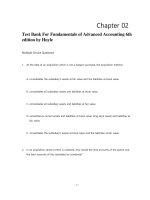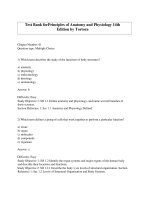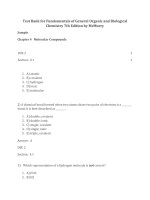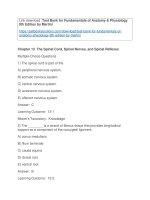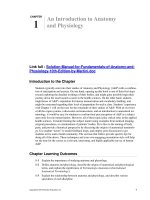Test bank for fundamentals of anatomy and physiology 11e c15
Bạn đang xem bản rút gọn của tài liệu. Xem và tải ngay bản đầy đủ của tài liệu tại đây (469.47 KB, 30 trang )
Chapterȱ15 SensoryȱPathwaysȱandȱtheȱSomatic
NervousȱSystem
Multiple Choice Questions
1) Theȱtermȱgeneralȱsensesȱrefersȱtoȱsensitivityȱtoȱallȱofȱtheȱfollowing,ȱexcept
A) temperature.
B) taste.
C) touch.
D) vibration.
E) pain.
Answer: B
LearningȱOutcome: 15-1
BloomȇsȱTaxonomy: Remembering
2) Theȱsensoryȱreceptors,ȱneuronsȱandȱpathwaysȱmakeȱupȱtheȱ________ȱdivisionȱofȱtheȱnervous
system.
A) voluntary
B) efferent
C) afferent
D) involuntary
E) somatic
Answer: C
LearningȱOutcome: 15-1
BloomȇsȱTaxonomy: Remembering
3) Theȱgeneralȱsenses
A) involveȱreceptorsȱthatȱareȱrelativelyȱsimpleȱinȱstructure.
B) areȱlocatedȱinȱspecializedȱstructuresȱcalledȱsenseȱorgans.
C) areȱlocalizedȱtoȱspecificȱareasȱofȱtheȱbody.
D) cannotȱgenerateȱactionȱpotentials.
E) includeȱtasteȱandȱsmell.
Answer: A
LearningȱOutcome: 15-1
BloomȇsȱTaxonomy: Remembering
4) Theȱ________ȱnervousȱsystemȱcarriesȱimpulsesȱtoȱskeletalȱmuscles.
A) somatic
B) sympathetic
C) parasympathetic
D) afferent
E) autonomic
Answer: A
LearningȱOutcome: 15-1
BloomȇsȱTaxonomy: Remembering
Copyrightȱ©ȱ2018ȱPearsonȱEducation,ȱInc.
474ȱȱȱTestȱBankȱforȱFundamentalsȱofȱAnatomyȱ&ȱPhysiology,ȱ11e
5) Theȱheartȱmuscleȱisȱaȱ________ȱeffector.
A) somatic
B) sympathetic
C) visceral
D) afferent
E) higher-order
Answer: C
LearningȱOutcome: 15-1
BloomȇsȱTaxonomy: Remembering
6) Theȱconversionȱofȱtheȱstimulusȱintoȱanȱactionȱpotentialȱtoȱbeȱinterpretedȱbyȱtheȱbrainȱisȱcalled
A) transformation.
B) transduction.
C) translation.
D) transcription.
E) transpotential.
Answer: B
LearningȱOutcome: 15-1
BloomȇsȱTaxonomy: Remembering
7) Gustatoryȱreceptorsȱareȱsensitiveȱtoȱdissolvedȱchemicalsȱbutȱinsensitiveȱtoȱlight.ȱThisȱisȱdueȱto
A) receptorȱspecificity.
B) accessoryȱcells.
C) theȱfactȱthatȱtheyȱareȱinteroceptors.
D) receptorȱpotentials.
E) receptorȱspeciation.
Answer: A
LearningȱOutcome: 15-2
BloomȇsȱTaxonomy: Understanding
8) Usingȱtheȱtwo-pointȱdiscriminationȱtestȱyouȱcanȱfairlyȱaccuratelyȱdetermineȱwhetherȱyouȱhave
beenȱtouchedȱwithȱoneȱpointȱorȱtwoȱbecauseȱofȱtheȱdensityȱofȱthe
A) effectors.
B) perception.
C) labeledȱline.
D) receptorȱfields.
E) actionȱpotential.
Answer: D
LearningȱOutcome: 15-2
BloomȇsȱTaxonomy: Remembering
9) Generalȱsenseȱreceptorsȱareȱtypicallyȱthe
A) dendritesȱofȱmotorȱneurons.
B) dendritesȱofȱsensoryȱneurons.
C) axonsȱofȱmotorȱneurons.
D) axonsȱofȱsensoryȱneurons.
E) cellȱbodiesȱofȱsensoryȱneurons.
Answer: B
LearningȱOutcome: 15-2
BloomȇsȱTaxonomy: Remembering
Copyrightȱ©ȱ2018ȱPearsonȱEducation,ȱInc.
Chapterȱ15ȱȱSensoryȱPathwaysȱandȱtheȱSomaticȱNervousȱSystemȱȱȱ475
10) Yourȱbrainȱisȱnotȱconstantlyȱbombardedȱwithȱsignalsȱtellingȱitȱthatȱyouȱareȱwearingȱsocks.ȱThis
isȱbecauseȱtheȱtouchȱreceptorsȱaroundȱyourȱankleȱare
A) tonicȱreceptors.
B) tonicȱreceptorsȱandȱslow-adapting.
C) phasicȱreceptorsȱandȱslow-adapting.
D) phasicȱreceptorsȱandȱfast-adapting.
E) nociceptors.
Answer: D
LearningȱOutcome: 15-2
BloomȇsȱTaxonomy: Understanding
11) Whichȱisȱanȱexampleȱofȱaȱslow-adaptingȱreceptor?
A) phasic
B) touch
C) smell
D) temperature
E) pain
Answer: E
LearningȱOutcome: 15-2
BloomȇsȱTaxonomy: Remembering
12) Inȱorderȱforȱaȱsensationȱtoȱbecomeȱaȱperception,
A) itȱmustȱbeȱreceivedȱbyȱtheȱsomatosensoryȱcortex.
B) theȱindividualȱmustȱvocalizeȱaboutȱit.
C) itȱmustȱarriveȱoverȱfast-conductingȱnerveȱfibers.
D) theȱotherȱsensesȱmustȱbeȱsilent.
E) itȱmustȱbeȱreceivedȱbyȱtheȱpulvinarȱnucleusȱofȱtheȱthalamus.
Answer: A
LearningȱOutcome: 15-2
BloomȇsȱTaxonomy: Understanding
13) Allȱofȱtheȱfollowingȱcanȱcontributeȱtoȱreceptorȱspecificityȱexcept
A) theȱstructureȱofȱtheȱreceptorȱcell.
B) characteristicsȱofȱtheȱreceptorȱcellȱmembrane.
C) accessoryȱcellsȱthatȱfunctionȱwithȱtheȱreceptor.
D) accessoryȱstructuresȱandȱtissuesȱthatȱshieldȱtheȱreceptorsȱfromȱotherȱstimuli.
E) theȱmetabolismȱofȱtheȱreceptorȱcell.
Answer: E
LearningȱOutcome: 15-2
BloomȇsȱTaxonomy: Understanding
14) Centralȱadaptationȱrefersȱto
A) theȱdeclineȱinȱactivityȱofȱperipheralȱreceptorsȱwhenȱstimulated.
B) aȱcharacteristicȱofȱphasicȱreceptors.
C) inhibitionȱofȱnucleiȱlocatedȱalongȱaȱsensoryȱpathway.
D) increasesȱinȱconsciousȱperceptionȱofȱaȱsensoryȱstimulus.
E) aȱchangeȱinȱmotorȱreceptivityȱofȱaȱneuron.
Answer: C
LearningȱOutcome: 15-2
BloomȇsȱTaxonomy: Remembering
Copyrightȱ©ȱ2018ȱPearsonȱEducation,ȱInc.
476ȱȱȱTestȱBankȱforȱFundamentalsȱofȱAnatomyȱ&ȱPhysiology,ȱ11e
15) Aȱreceptorȱpotentialȱmayȱcauseȱallȱofȱtheȱfollowingȱresponsesȱexcept
A) increaseȱneurotransmitterȱrelease.
B) decreaseȱneurotransmitterȱrelease.
C) causeȱhyperpolarization.
D) causeȱdepolarization.
E) turningȱoffȱtheȱoriginalȱstimulus.
Answer: E
LearningȱOutcome: 15-2
BloomȇsȱTaxonomy: Remembering
16) Peripheralȱadaptationȱ________ȱtheȱnumberȱofȱactionȱpotentialsȱthatȱreachȱtheȱCNS.
A) decreases
B) increases
C) stabilizes
D) neutralizes
E) amplifies
Answer: A
LearningȱOutcome: 15-2
BloomȇsȱTaxonomy: Understanding
17) Whichȱofȱtheȱfollowingȱstatementsȱisȱtrue aboutȱgeneralȱsenses?
A) Theyȱareȱdistributedȱallȱoverȱtheȱbody.
B) Theyȱareȱallȱmechanoreceptors.
C) Allȱreceptorsȱinvolvedȱinȱgeneralȱsensationȱconsistȱofȱfreeȱnerveȱendings.
D) Theyȱareȱlocatedȱinȱsenseȱorgans.
E) Theȱreceptionȱofȱtheȱstimulusȱoccursȱslowlyȱwithȱtheseȱreceptors.
Answer: A
LearningȱOutcome: 15-2
BloomȇsȱTaxonomy: Understanding
18) Sensoryȱencodingȱofȱtheȱperceivedȱlocation ofȱaȱstimulusȱdependsȱon
A) theȱfrequencyȱofȱactionȱpotentials.
B) whichȱlabeledȱlineȱisȱactive.
C) theȱspecificȱlocationȱofȱtheȱcorticalȱneuronȱthatȱisȱstimulated.
D) theȱspecificȱsensitivityȱofȱtheȱperipheralȱreceptor.
E) theȱnumberȱofȱreceptorsȱstimulated.
Answer: C
LearningȱOutcome: 15-2
BloomȇsȱTaxonomy: Remembering
19) Actionȱpotentialsȱfromȱreceptorsȱinvolvedȱinȱgeneralȱsensationsȱareȱinterpretedȱinȱthe
A) premotorȱcortex.
B) primaryȱsensoryȱcortex.
C) generalȱinterpretiveȱarea.
D) mesencephalon.
E) reticularȱactivatingȱsystem.
Answer: B
LearningȱOutcome: 15-2
BloomȇsȱTaxonomy: Remembering
Copyrightȱ©ȱ2018ȱPearsonȱEducation,ȱInc.
Chapterȱ15ȱȱSensoryȱPathwaysȱandȱtheȱSomaticȱNervousȱSystemȱȱȱ477
20) Sensoryȱinformationȱfromȱallȱpartsȱofȱtheȱbodyȱisȱroutedȱto
A) theȱprefrontalȱcortex.
B) theȱcerebellum.
C) theȱprimaryȱmotorȱcortex.
D) theȱsomatosensoryȱcortex.
E) Brocaȇsȱarea.
Answer: D
LearningȱOutcome: 15-2
BloomȇsȱTaxonomy: Remembering
21) Theȱconversionȱofȱaȱsensoryȱinputȱtoȱaȱchangeȱinȱmembraneȱpotentialȱinȱtheȱreceptorȱisȱknown
as
A) transduction.
B) reception.
C) effection.
D) potential.
E) stimulation.
Answer: A
LearningȱOutcome: 15-2
BloomȇsȱTaxonomy: Remembering
22) Theȱlinkȱbetweenȱperipheralȱreceptorȱandȱcorticalȱneuronȱisȱcalledȱa(n)
A) efferentȱpathway.
B) spinocorticalȱline.
C) sympatheticȱchain.
D) adaptationȱpathway.
E) labeledȱline.
Answer: E
LearningȱOutcome: 15-2
BloomȇsȱTaxonomy: Remembering
23) Aȱ________ȱpotentialȱisȱaȱdepolarizationȱofȱaȱsensoryȱdendriteȱthatȱcanȱleadȱtoȱanȱafferent
nerveȱimpulseȱifȱstrongȱenough.
A) resting
B) refractory
C) postsynaptic
D) generator
E) presynaptic
Answer: D
LearningȱOutcome: 15-2
BloomȇsȱTaxonomy: Remembering
Copyrightȱ©ȱ2018ȱPearsonȱEducation,ȱInc.
478ȱȱȱTestȱBankȱforȱFundamentalsȱofȱAnatomyȱ&ȱPhysiology,ȱ11e
24) Sensoryȱneuronsȱthatȱadaptȱquicklyȱareȱcalledȱ________ȱreceptors.
A) phasic
B) tonic
C) intracellular
D) chemical-channel
E) opioid
Answer: A
LearningȱOutcome: 15-2
BloomȇsȱTaxonomy: Remembering
25) Aȱreductionȱinȱsensitivityȱinȱtheȱpresenceȱofȱaȱconstantȱstimulusȱisȱreferredȱtoȱas
A) transduction.
B) adaptation.
C) negation.
D) exhaustion.
E) transformation.
Answer: B
LearningȱOutcome: 15-2
BloomȇsȱTaxonomy: Remembering
26) Sensoryȱneuronsȱthatȱareȱalwaysȱactiveȱareȱcalledȱ________ȱreceptors.
A) tonic
B) static
C) phasic
D) isometric
E) isotonic
Answer: A
LearningȱOutcome: 15-2
BloomȇsȱTaxonomy: Remembering
27) Youȱcannotȱtellȱwhenȱyourȱsmallȱintestinesȱshiftȱpositionȱasȱfoodȱentersȱbecauseȱyouȱdoȱnot
haveȱanyȱ________ȱthere.
A) chemoreceptors
B) nociceptors
C) proprioceptors
D) thermoreceptors
E) photoreceptors
Answer: C
LearningȱOutcome: 15-3
BloomȇsȱTaxonomy: Understanding
Copyrightȱ©ȱ2018ȱPearsonȱEducation,ȱInc.
Chapterȱ15ȱȱSensoryȱPathwaysȱandȱtheȱSomaticȱNervousȱSystemȱȱȱ479
28) ReceptorsȱinȱyourȱstomachȱthatȱdetermineȱwhenȱfoodȱentersȱbecauseȱtheȱpHȱchangesȱwouldȱbe
classifiedȱas
A) mechanoreceptors.
B) nociceptors.
C) proprioceptors.
D) baroreceptors.
E) chemoreceptors.
Answer: E
LearningȱOutcome: 15-3
BloomȇsȱTaxonomy: Understanding
29) Freeȱnerveȱendingsȱdetectȱwhichȱstimulus/stimuli?
A) chemical
B) temperature,ȱpain,ȱstretchȱandȱtouch
C) painȱonly
D) stretch
E) deepȱpressure
Answer: B
LearningȱOutcome: 15-3
BloomȇsȱTaxonomy: Remembering
30) Twoȱtypesȱofȱreceptorsȱthatȱareȱleastȱlikelyȱtoȱadaptȱareȱthe
A) proprioceptorsȱandȱnociceptors.
B) freeȱnerveȱendingsȱandȱtheȱrootȱhairȱplexus.
C) tactileȱdiscsȱandȱtheȱfreeȱnerveȱendings.
D) lamellarȱcorpusclesȱandȱbaroreceptors.
E) chemoreceptorsȱandȱbaroreceptors.
Answer: A
LearningȱOutcome: 15-3
BloomȇsȱTaxonomy: Remembering
31) Chemoreceptorsȱofȱtheȱgeneralȱsensesȱdoȱnotȱsendȱinformationȱtoȱtheȱprimaryȱsensoryȱcortex
butȱinsteadȱsendȱinformationȱtoȱtheȱ________ȱtoȱcontrolȱautonomicȱfunction.
A) cerebellum
B) cerebrum
C) brainȱstem
D) spinalȱcord
E) corpusȱcallosum
Answer: C
LearningȱOutcome: 15-3
BloomȇsȱTaxonomy: Understanding
Copyrightȱ©ȱ2018ȱPearsonȱEducation,ȱInc.
480ȱȱȱTestȱBankȱforȱFundamentalsȱofȱAnatomyȱ&ȱPhysiology,ȱ11e
32) Aȱreceptorȱthatȱcontainsȱmanyȱmechanically-gatedȱionȱchannelsȱwouldȱfunctionȱbestȱasȱa
A) tactileȱreceptor.
B) chemoreceptor.
C) photoceptor.
D) thermoreceptor.
E) lightȱreceptor.
Answer: A
LearningȱOutcome: 15-3
BloomȇsȱTaxonomy: Remembering
33) Aȱmechanoreceptorȱinȱtheȱpapillaryȱlayerȱofȱtheȱdermisȱthatȱrespondsȱtoȱfineȱtouchȱisȱa
A) tactileȱ(Merkel)ȱdisc.
B) rootȱhairȱplexus.
C) freeȱnerveȱending.
D) Bulbousȱcorpuscle.
E) tactileȱ(Meissner)ȱcorpuscle.
Answer: E
LearningȱOutcome: 15-3
BloomȇsȱTaxonomy: Remembering
34) Whichȱofȱtheȱfollowingȱis/areȱsometimesȱcalledȱȈpricklingȱpainȈ?
A) mechanicalȱdamage
B) proprioception
C) extremesȱofȱtemperature
D) fastȱpain
E) fastȱandȱslowȱpain
Answer: D
LearningȱOutcome: 15-3
BloomȇsȱTaxonomy: Remembering
35) Allȱofȱtheȱfollowingȱareȱtrueȱofȱfastȱpainȱsensations exceptȱthatȱthey
A) areȱcarriedȱbyȱtypeȱAȱfibers.
B) reachȱtheȱCNSȱquickly.
C) areȱinterpretedȱbyȱtheȱpre-frontalȱcortex.
D) receiveȱconsciousȱattention.
E) oftenȱtriggerȱsomaticȱreflexes.
Answer: C
LearningȱOutcome: 15-3
BloomȇsȱTaxonomy: Understanding
36) Endorphinsȱcanȱreduceȱperceptionȱofȱsensationsȱinitiatedȱby
A) nociceptors.
B) mechanoreceptors.
C) thermoreceptors.
D) chemoreceptors.
E) proprioceptors.
Answer: A
LearningȱOutcome: 15-3
BloomȇsȱTaxonomy: Remembering
Copyrightȱ©ȱ2018ȱPearsonȱEducation,ȱInc.
Chapterȱ15ȱȱSensoryȱPathwaysȱandȱtheȱSomaticȱNervousȱSystemȱȱȱ481
37) Receptorsȱthatȱmonitorȱtheȱpositionȱofȱjointsȱbelongȱtoȱtheȱcategoryȱcalled
A) nociceptors.
B) chemoreceptors.
C) baroreceptors.
D) proprioceptors.
E) thermoreceptors.
Answer: D
LearningȱOutcome: 15-3
BloomȇsȱTaxonomy: Remembering
38) Mechanoreceptorsȱthatȱrespondȱtoȱchangesȱinȱbloodȱpressureȱareȱcalled
A) nociceptors.
B) baroreceptors.
C) chemoreceptors.
D) proprioceptors.
E) thermoreceptors.
Answer: B
LearningȱOutcome: 15-3
BloomȇsȱTaxonomy: Remembering
39) Tactileȱreceptorsȱlocatedȱinȱtheȱreticularȱdermisȱthatȱareȱtonicȱandȱshowȱlittleȱifȱanyȱadaptation
areȱcalled
A) Bulbousȱcorpuscles.
B) lamellarȱcorpuscles.
C) tactileȱ(Meissner)ȱcorpuscles.
D) tactileȱdiscs.
E) rootȱhairȱplexuses.
Answer: A
LearningȱOutcome: 15-3
BloomȇsȱTaxonomy: Remembering
40) Aȱtactileȱreceptorȱcomposedȱofȱhighlyȱcoiledȱdendritesȱthatȱareȱsurroundedȱbyȱmodified
Schwannȱcellsȱandȱaȱfibrousȱcapsuleȱisȱa
A) lamellarȱcorpuscle.
B) Bulbousȱcorpuscle.
C) tactileȱ(Meissner)ȱcorpuscle.
D) tactileȱ(Merkel)ȱdisc.
E) rootȱhairȱplexus.
Answer: C
LearningȱOutcome: 15-3
BloomȇsȱTaxonomy: Remembering
Copyrightȱ©ȱ2018ȱPearsonȱEducation,ȱInc.
482ȱȱȱTestȱBankȱforȱFundamentalsȱofȱAnatomyȱ&ȱPhysiology,ȱ11e
41) Aȱveryȱlarge,ȱfast-adaptingȱtactileȱreceptorȱthatȱisȱcomposedȱofȱaȱsingleȱdendriteȱenclosedȱby
concentricȱlayersȱofȱcollagenȱisȱa
A) Bulbousȱcorpuscle.
B) lamellarȱ(Pacinian)ȱcorpuscle.
C) tactileȱ(Meissner)ȱcorpuscle.
D) tactileȱ(Merkel)ȱdisc.
E) rootȱhairȱplexus.
Answer: B
LearningȱOutcome: 15-3
BloomȇsȱTaxonomy: Remembering
42) Sensationsȱofȱburningȱorȱachingȱpain
A) areȱcarriedȱbyȱtypeȱAȱfibers.
B) reachȱtheȱCNSȱquickly.
C) causeȱaȱgeneralizedȱactivationȱofȱtheȱreticularȱformationȱandȱtheȱthalamus.
D) areȱwellȱlocalized.
E) areȱfastȱadapting.
Answer: C
LearningȱOutcome: 15-3
BloomȇsȱTaxonomy: Understanding
43) Bladderȱfullnessȱisȱtoȱ________ȱasȱbloodȱpHȱisȱtoȱ________.
A) nociceptors;ȱthermoreceptors
B) baroreceptors;ȱchemoreceptors
C) baroreceptors;ȱnociceptors
D) chemoreceptors;ȱnociceptors
E) baroreceptors;ȱthermoreceptors
Answer: B
LearningȱOutcome: 15-3
BloomȇsȱTaxonomy: Understanding
44) Aȱhighlyȱsensitiveȱtactileȱreceptorȱcomposedȱofȱdendriticȱprocessesȱofȱaȱsingleȱmyelinatedȱfiber
thatȱmakesȱcontactȱwithȱspecializedȱcellsȱofȱtheȱstratumȱbasaleȱisȱa
A) lamellarȱcorpuscle.
B) tactileȱ(Meissner)ȱcorpuscle.
C) Bulbousȱcorpuscle.
D) tactileȱ(Merkel)ȱdisc.
E) rootȱhairȱplexus.
Answer: D
LearningȱOutcome: 15-3
BloomȇsȱTaxonomy: Remembering
Copyrightȱ©ȱ2018ȱPearsonȱEducation,ȱInc.
Chapterȱ15ȱȱSensoryȱPathwaysȱandȱtheȱSomaticȱNervousȱSystemȱȱȱ483
45) Aȱsensoryȱreceptorȱcharacterizedȱperipherallyȱasȱaȱfreeȱnerveȱendingȱwhichȱcentrallyȱuses
glutamateȱand/orȱsubstanceȱPȱasȱneurotransmittersȱwouldȱmostȱlikelyȱbeȱa
A) chemoreceptor.
B) mechanoreceptor.
C) thermoreceptor.
D) nociceptor.
E) freeȱreceptor.
Answer: D
LearningȱOutcome: 15-3
BloomȇsȱTaxonomy: Remembering
46) Weȱareȱconstantlyȱbombardedȱbyȱaȱvarietyȱofȱstimuliȱinsideȱandȱoutsideȱofȱourȱbodies.ȱWhy
areȱweȱnotȱoverwhelmedȱbyȱsensoryȱinformation?
A) Weȱdoȱnotȱhaveȱreceptorsȱforȱmostȱstimuli.
B) Stimuliȱareȱblockedȱfromȱtheȱreceptorsȱbyȱourȱimmuneȱsystems.
C) Mostȱstimuliȱareȱexternalȱtoȱourȱbodiesȱandȱweȱhaveȱveryȱfewȱexteroceptorsȱonȱthe
outsideȱofȱtheȱbody.
D) Aȱparticularȱreceptorȱtypeȱcanȱhaveȱdifferentȱsensitivitiesȱtoȱdifferentȱstimuli.
E) Aȱveryȱtinyȱpercentageȱofȱincomingȱsensoryȱinformationȱisȱreceivedȱbyȱtheȱcerebral
cortex.
Answer: E
LearningȱOutcome: 15-3
BloomȇsȱTaxonomy: Understanding
47) Painȱisȱtoȱ________ȱasȱcoldȱisȱtoȱ________.
A) nociceptors;ȱthermoreceptors
B) baroreceptors;ȱchemoreceptors
C) baroreceptors;ȱnociceptors
D) chemoreceptors;ȱnociceptors
E) baroreceptors;ȱthermoreceptors
Answer: A
LearningȱOutcome: 15-3
BloomȇsȱTaxonomy: Understanding
48) Ifȱaȱfriendȱisȱtalkingȱaboutȱsomeoneȱsheȱknowsȱwhoȱlostȱhisȱspecialȱsenses,ȱyouȱwouldȱcorrect
herȱwhenȱyouȱhearȱherȱmentionȱ________ȱbecauseȱitȱisȱnotȱaȱspecialȱsense.
A) smell
B) sight
C) balance
D) cold
E) hearing
Answer: D
LearningȱOutcome: 15-3
BloomȇsȱTaxonomy: Remembering
Copyrightȱ©ȱ2018ȱPearsonȱEducation,ȱInc.
484ȱȱȱTestȱBankȱforȱFundamentalsȱofȱAnatomyȱ&ȱPhysiology,ȱ11e
49) ________ȱareȱreceptorsȱinȱtheȱaortaȱthatȱmonitorȱtheȱbloodȱpressure.
A) Chemoreceptors
B) Nociceptors
C) Baroreceptors
D) Proprioceptors
E) Hairȱcells
Answer: C
LearningȱOutcome: 15-3
BloomȇsȱTaxonomy: Understanding
50) Whichȱofȱtheȱfollowingȱisȱaȱpropertyȱofȱthermoreceptors?
A) involvesȱspecializedȱreceptors
B) monitorȱheatȱstimuli,ȱnotȱcold
C) foundȱinȱskinȱonly
D) projectȱtoȱreticularȱformation
E) coldȱreceptorsȱareȱlessȱnumerousȱthanȱwarmȱreceptors
Answer: D
LearningȱOutcome: 15-3
BloomȇsȱTaxonomy: Understanding
51) Forȱtheȱlastȱfewȱweeks,ȱyouȱhaveȱhadȱanȱoddȱsensationȱonȱyourȱupperȱthigh.ȱWhenȱyouȱtouch
theȱnakedȱskin,ȱitȱfeelsȱveryȱstrange,ȱlikeȱyouȱareȱtouchingȱyourȱskinȱthroughȱlayersȱofȱcloth.
Theȱsurroundingȱareaȱfeelsȱnormal.ȱYourȱdoctorȱthinksȱthatȱthisȱmayȱbeȱrelatedȱtoȱspinalȱnerve
damageȱrelatedȱtoȱaȱherniatedȱdisc.ȱTheȱdoctorȱcallsȱthisȱchangeȱinȱsensation
A) paresthesia.
B) anesthesia.
C) hypesthesia.
D) synesthesia.
E) kinesthesia.
Answer: A
LearningȱOutcome: 15-3
BloomȇsȱTaxonomy: Understanding
52) Chemoreceptorsȱareȱlocatedȱinȱallȱofȱtheȱfollowingȱexcept
A) carotidȱbodies.
B) aorticȱbodies.
C) theȱskin.
D) theȱorgansȱofȱtaste.
E) theȱorgansȱofȱsmell.
Answer: C
LearningȱOutcome: 15-3
BloomȇsȱTaxonomy: Remembering
Copyrightȱ©ȱ2018ȱPearsonȱEducation,ȱInc.
Chapterȱ15ȱȱSensoryȱPathwaysȱandȱtheȱSomaticȱNervousȱSystemȱȱȱ485
53) Whyȱisȱitȱthatȱoneȱcannotȱidentifyȱtheȱlocationȱofȱinternalȱorgans,ȱalthoughȱjointsȱandȱbone
locationȱcanȱbeȱidentified?
A) Theȱinternalȱorgansȱhaveȱnoȱproprioceptorsȱlikeȱjoints,ȱbones,ȱandȱmuscles.
B) Internalȱorgansȱhaveȱnoȱpainȱreceptors.
C) Althoughȱinternalȱorgansȱhaveȱsomeȱreceptors,ȱtheȱinformationȱisȱnotȱinterpretedȱbyȱthe
brain.
D) Internalȱorgansȱhaveȱnoȱreceptorsȱofȱanyȱkind.
E) Sensoryȱinformationȱfromȱinternalȱorgansȱisȱprocessedȱbyȱaȱdifferentȱpartȱofȱtheȱbrain
thanȱtheȱjoints,ȱbones,ȱandȱmuscles.
Answer: A
LearningȱOutcome: 15-3
BloomȇsȱTaxonomy: Understanding
54) SensoryȱneuronsȱsynapseȱinȱtheȱCNSȱwithȱanȱinterneuronȱknownȱasȱa
A) first-orderȱneuron.
B) second-orderȱneuron.
C) third-orderȱneuron.
D) motorȱneuron.
E) efferentȱneuron.
Answer: B
LearningȱOutcome: 15-4
BloomȇsȱTaxonomy: Remembering
55) Allȱofȱtheȱfollowingȱpathwaysȱrequireȱthird-orderȱneuronsȱsynapsingȱinȱtheȱthalamusȱexcept
A) theȱlateralȱspinothalamicȱtract.
B) theȱanteriorȱspinothalamicȱtract.
C) theȱanteriorȱandȱposteriorȱspinocerebellarȱtracts.
D) theȱgracileȱfasciculus.
E) theȱcuneateȱfasciculus.
Answer: C
LearningȱOutcome: 15-4
BloomȇsȱTaxonomy: Understanding
56) Whichȱofȱtheȱfollowingȱisȱtrue ofȱallȱtheȱsensoryȱpathways?
A) Theyȱallȱhaveȱthird-orderȱneurons.
B) Theyȱallȱsynapseȱinȱtheȱthalamus.
C) Theyȱallȱsynapseȱinȱtheȱcerebellum.
D) Theyȱallȱenterȱthroughȱdorsalȱroots.
E) Axonsȱinȱeachȱpathwayȱdecussate.
Answer: D
LearningȱOutcome: 15-4
BloomȇsȱTaxonomy: Understanding
Copyrightȱ©ȱ2018ȱPearsonȱEducation,ȱInc.
486ȱȱȱTestȱBankȱforȱFundamentalsȱofȱAnatomyȱ&ȱPhysiology,ȱ11e
57) Activityȱofȱneuronsȱinȱtheȱspinothalamicȱpathwayȱmayȱstillȱsendȱsignalsȱevenȱifȱtheȱfirstȱorder
sensoryȱreceptorȱdoesȱnotȱreceiveȱaȱsignalȱsuchȱasȱinȱamputation.ȱThisȱsituationȱmightȱcause
A) referredȱpain.
B) phantomȱlimbȱpain.
C) painȱadaptation.
D) paresthesia.
E) anesthesia.
Answer: B
LearningȱOutcome: 15-4
BloomȇsȱTaxonomy: Understanding
58) Whichȱascendingȱtractȱcarriesȱtheȱsensationsȱforȱfineȱtouchȱandȱvibration?
A) corticobulbar
B) corticospinal
C) posteriorȱ(dorsal)ȱcolumn
D) spinothalamic
E) spinocerebellar
Answer: C
LearningȱOutcome: 15-4
BloomȇsȱTaxonomy: Remembering
59) TheȱspinalȱtractȱthatȱrelaysȱinformationȱconcerningȱpainȱandȱtemperatureȱtoȱtheȱCNSȱisȱthe
A) gracileȱfasciculus.
B) cuneateȱfasciculus.
C) posteriorȱspinocerebellar.
D) lateralȱspinothalamic.
E) anteriorȱspinothalamic.
Answer: D
LearningȱOutcome: 15-4
BloomȇsȱTaxonomy: Remembering
60) Yourȱuncleȱwasȱjustȱdiagnosedȱwithȱaȱheartȱattack.ȱOneȱofȱhisȱmajorȱsymptomsȱisȱleftȱarmȱpain.
Youȱareȱnotȱsurprisedȱbecauseȱyouȱareȱfamiliarȱwithȱtheȱphenomenonȱofȱ________ȱpain.
A) referred
B) phantom
C) psychosomatic
D) somatic
E) neurogenic
Answer: A
LearningȱOutcome: 15-4
BloomȇsȱTaxonomy: Understanding
Copyrightȱ©ȱ2018ȱPearsonȱEducation,ȱInc.
Chapterȱ15ȱȱSensoryȱPathwaysȱandȱtheȱSomaticȱNervousȱSystemȱȱȱ487
61) Stimulationȱofȱaȱneuronȱthatȱterminatesȱinȱtheȱsuperiorȱregionȱofȱtheȱleftȱpostcentralȱgyrus
wouldȱproduce
A) aȱsensationȱinȱtheȱrightȱleg.
B) aȱsensationȱinȱtheȱlips.
C) aȱmuscleȱtwitchȱinȱtheȱrightȱleg.
D) aȱmuscleȱtwitchȱinȱtheȱlips.
E) bothȱsensationsȱandȱmuscleȱtwitchesȱinȱtheȱrightȱleg.
Answer: A
LearningȱOutcome: 15-4
BloomȇsȱTaxonomy: Understanding
62) TheȱspinalȱtractȱthatȱrelaysȱinformationȱconcerningȱcrudeȱtouchȱandȱpressureȱtoȱtheȱCNSȱisȱthe
A) gracileȱfasciculus.
B) cuneateȱfasciculus.
C) posteriorȱspinocerebellar.
D) lateralȱspinothalamic.
E) anteriorȱspinothalamic.
Answer: E
LearningȱOutcome: 15-4
BloomȇsȱTaxonomy: Remembering
63) Eachȱofȱtheȱfollowingȱisȱanȱascendingȱtractȱinȱtheȱspinalȱcordȱ exceptȱthe
A) gracileȱfasciculus.
B) cuneateȱfasciculus.
C) posteriorȱspinocerebellar.
D) reticulospinalȱtract.
E) anteriorȱspinothalamic.
Answer: D
LearningȱOutcome: 15-4
BloomȇsȱTaxonomy: Remembering
64) TheȱafferentȱneuronȱthatȱcarriesȱtheȱsensationȱandȱentersȱtheȱCNSȱisȱaȱ________ȱneuron.
A) receptor
B) first-order
C) second-order
D) third-order
E) fourth-order
Answer: B
LearningȱOutcome: 15-4
BloomȇsȱTaxonomy: Remembering
65) Whatȱlossȱwouldȱresultȱfromȱcuttingȱthroughȱtheȱmedialȱlemniscusȱonȱtheȱrightȱside?
A) lossȱofȱpainȱsensationȱonȱtheȱleftȱsideȱofȱtheȱbody
B) lossȱofȱpainȱsensationȱonȱtheȱrightȱsideȱofȱtheȱbody
C) lossȱofȱfineȱtouchȱsensationȱonȱtheȱleftȱsideȱofȱtheȱbody
D) lossȱofȱfineȱtouchȱsensationȱonȱtheȱrightȱsideȱofȱtheȱbody
E) completeȱhemiplegiaȱ(paralysis)ȱonȱtheȱleftȱsideȱofȱtheȱbody
Answer: C
LearningȱOutcome: 15-4
BloomȇsȱTaxonomy: Understanding
Copyrightȱ©ȱ2018ȱPearsonȱEducation,ȱInc.
488ȱȱȱTestȱBankȱforȱFundamentalsȱofȱAnatomyȱ&ȱPhysiology,ȱ11e
66) Thalamicȱneuronsȱthatȱprojectȱtoȱtheȱprimaryȱsensoryȱcortexȱareȱ________ȱneurons.
A) receptor
B) first-order
C) second-order
D) third-order
E) fourth-order
Answer: D
LearningȱOutcome: 15-4
BloomȇsȱTaxonomy: Remembering
67) WhichȱneuronȱdeliversȱsensationsȱtoȱtheȱCNS?
A) first-order
B) second-order
C) third-order
D) fourth-order
E) sensoryȱreceptor
Answer: A
LearningȱOutcome: 15-4
BloomȇsȱTaxonomy: Remembering
68) Weȱcanȱlocalizeȱsensationsȱthatȱoriginateȱinȱdifferentȱareasȱofȱtheȱbodyȱbecause
A) sensoryȱneuronsȱcarryȱonlyȱoneȱmodality.
B) sensoryȱneuronsȱfromȱspecificȱbodyȱregionsȱprojectȱtoȱspecificȱcorticalȱregions.
C) incomingȱsensoryȱinformationȱisȱfirstȱprocessedȱbyȱtheȱthalamus.
D) differentȱtypesȱofȱsensoryȱreceptorsȱproduceȱactionȱpotentialsȱofȱdifferentȱsizesȱand
shapes.
E) ofȱtheȱmanyȱtypesȱofȱtactileȱreceptors.
Answer: B
LearningȱOutcome: 15-4
BloomȇsȱTaxonomy: Remembering
Copyrightȱ©ȱ2018ȱPearsonȱEducation,ȱInc.
Chapterȱ15ȱȱSensoryȱPathwaysȱandȱtheȱSomaticȱNervousȱSystemȱȱȱ489
Figureȱ15-1ȱSpinothalamicȱTracts
UseȱFigureȱ15-1ȱtoȱanswerȱtheȱfollowingȱquestions:
69) IdentifyȱtheȱaxonȱlabeledȱȈ3.Ȉ
A) axonȱofȱaȱlowerȱmotorȱneuron
B) axonȱofȱaȱupperȱmotorȱneuron
C) axonȱofȱaȱfirst-orderȱneuron
D) axonȱofȱaȱsecond-orderȱneuron
E) axonȱofȱaȱganglionicȱneuron
Answer: D
LearningȱOutcome: 15-4
BloomȇsȱTaxonomy: Understanding
Copyrightȱ©ȱ2018ȱPearsonȱEducation,ȱInc.
490ȱȱȱTestȱBankȱforȱFundamentalsȱofȱAnatomyȱ&ȱPhysiology,ȱ11e
70) WhereȱinȱtheȱspinalȱcordȱisȱtheȱstructureȱlabeledȱȈ2Ȉȱlocated?
A) anteriorȱgrayȱhorns
B) dorsalȱrootȱganglion
C) anteriorȱwhiteȱcolumn
D) anteriorȱmedianȱfissure
E) posteriorȱwhiteȱcolumn
Answer: C
LearningȱOutcome: 15-4
BloomȇsȱTaxonomy: Understanding
71) IdentifyȱtheȱneuronȱlabeledȱȈ1.Ȉ
A) lowerȱmotorȱneuron
B) upperȱmotorȱneuron
C) first-orderȱneuron
D) second-orderȱneuron
E) ganglionicȱneuron
Answer: C
LearningȱOutcome: 15-4
BloomȇsȱTaxonomy: Understanding
72) IdentifyȱtheȱstructureȱlabeledȱȈ5.Ȉ
A) thalamus
B) cerebralȱcortex
C) primaryȱmotorȱcortex
D) primaryȱsensoryȱcortex
E) autonomicȱganglion
Answer: A
LearningȱOutcome: 15-4
BloomȇsȱTaxonomy: Understanding
73) Theȱthird-orderȱneuronȱinȱthisȱpathwayȱsynapsesȱinȱwhatȱstructureȱlabeledȱȈ7Ȉ?
A) cerebellum
B) thalamus
C) primaryȱsensoryȱcortex
D) pons
E) medullaȱoblongata
Answer: C
LearningȱOutcome: 15-4
BloomȇsȱTaxonomy: Remembering
74) Whichȱstructureȱconductsȱactionȱpotentialsȱdirectlyȱfromȱaȱsensoryȱreceptor?
A) 1
B) 2
C) 3
D) 5
E) 7
Answer: A
LearningȱOutcome: 15-4
BloomȇsȱTaxonomy: Understanding
Copyrightȱ©ȱ2018ȱPearsonȱEducation,ȱInc.
Chapterȱ15ȱȱSensoryȱPathwaysȱandȱtheȱSomaticȱNervousȱSystemȱȱȱ491
75) IdentifyȱtheȱtypeȱofȱinformationȱthatȱtravelsȱalongȱtheȱstructureȱlabeledȱȈ2.Ȉ
A) motorȱcommandsȱtoȱskeletalȱmuscles
B) proprioceptionȱtoȱtheȱcerebralȱcortex
C) fineȱtouchȱtoȱtheȱcerebralȱcortex
D) crudeȱtouchȱandȱpressureȱsensations
E) visceralȱmotorȱcommandsȱtoȱsmoothȱmuscle
Answer: D
LearningȱOutcome: 15-4
BloomȇsȱTaxonomy: Understanding
76) Theȱsenseȱofȱproprioceptionȱpassesȱalongȱtheȱ________ȱpathway.
A) rubriocerebellar
B) corticospinal
C) spinocerebellar
D) decussationȱpathways
E) ganglion
Answer: C
LearningȱOutcome: 15-4
BloomȇsȱTaxonomy: Remembering
77) Inȱtheȱspinothalamicȱpathway,ȱtheȱsensoryȱneuronȱthatȱsynapsesȱwithȱaȱneuronȱinȱtheȱcerebral
cortexȱisȱcalledȱtheȱ________ȱneuron.
A) first-order
B) second-order
C) third-order
D) fourth-order
E) receptive
Answer: C
LearningȱOutcome: 15-4
BloomȇsȱTaxonomy: Remembering
78) Ascendingȱtractsȱinȱtheȱspinalȱcordȱrelayȱ________ȱinformation.
A) sensory
B) motor
C) sensoryȱandȱmotor
D) onlyȱsomatic
E) autonomic
Answer: A
LearningȱOutcome: 15-4
BloomȇsȱTaxonomy: Remembering
Copyrightȱ©ȱ2018ȱPearsonȱEducation,ȱInc.
492ȱȱȱTestȱBankȱforȱFundamentalsȱofȱAnatomyȱ&ȱPhysiology,ȱ11e
79) Whichȱofȱtheȱfollowingȱisȱaȱprogressive,ȱdegenerativeȱdisorderȱthatȱaffectsȱupperȱandȱlower
motorȱneuronsȱcausingȱskeletalȱmuscleȱatrophy?
A) cerebralȱpalsy
B) stroke
C) paralysis
D) amyotrophicȱlateralȱsclerosis
E) multipleȱsclerosis
Answer: D
LearningȱOutcome: 15-5
BloomȇsȱTaxonomy: Remembering
80) Inȱmotorȱpathways,ȱtheȱonlyȱportionȱofȱtheȱpathwayȱthatȱisȱoutsideȱofȱtheȱCNSȱisȱthe
A) lowerȱmotorȱneuron.
B) upperȱmotorȱneuron.
C) axonȱofȱtheȱlowerȱmotorȱneuron.
D) axonȱofȱtheȱupperȱmotorȱneuron.
E) interneuron.
Answer: C
LearningȱOutcome: 15-5
BloomȇsȱTaxonomy: Remembering
81) Whichȱmotorȱpathwayȱdoesȱnot endȱinȱtheȱspinalȱcord?
A) corticobulbarȱtract
B) corticospinalȱtract
C) vestibulospinalȱtract
D) tectospinalȱtract
E) rubrospinalȱtract
Answer: A
LearningȱOutcome: 15-5
BloomȇsȱTaxonomy: Remembering
82) Theȱcorticospinalȱpathwayȱbeginsȱinȱwhichȱareaȱofȱtheȱbrain?
A) somatosensoryȱcortex
B) primaryȱmotorȱcortex
C) midbrain
D) vestibularȱnuclei
E) redȱnuclei
Answer: B
LearningȱOutcome: 15-5
BloomȇsȱTaxonomy: Remembering
83) Theȱmotorȱhomunculusȱshowsȱlargerȱstructuresȱinȱareasȱofȱtheȱbodyȱthat
A) haveȱmoreȱsurfaceȱarea.
B) haveȱmoreȱsensoryȱreceptors.
C) haveȱbiggerȱskeletalȱmuscles.
D) areȱhighlyȱsensitive.
E) haveȱmoreȱmotorȱunits.
Answer: E
LearningȱOutcome: 15-5
BloomȇsȱTaxonomy: Understanding
Copyrightȱ©ȱ2018ȱPearsonȱEducation,ȱInc.
Chapterȱ15ȱȱSensoryȱPathwaysȱandȱtheȱSomaticȱNervousȱSystemȱȱȱ493
84) Theȱrubrospinalȱtractsȱoriginateȱinȱthe
A) primaryȱmotorȱcortex.
B) vestibularȱnuclei.
C) thalamus.
D) redȱnuclei.
E) reticularȱformation.
Answer: D
LearningȱOutcome: 15-5
BloomȇsȱTaxonomy: Remembering
85) Whichȱareasȱofȱtheȱbrainȱmonitorȱandȱadjustȱactivitiesȱofȱtheȱmotorȱpathways?
A) basalȱnuclei
B) cerebellum
C) basalȱnucleiȱandȱcerebellum
D) midbrain
E) pons
Answer: C
LearningȱOutcome: 15-5
BloomȇsȱTaxonomy: Remembering
86) Theȱneuronsȱofȱtheȱprimaryȱmotorȱcortexȱareȱ________ȱcells.
A) neuroglial
B) dendritic
C) pyramidal
D) cortical
E) astrocyte
Answer: C
LearningȱOutcome: 15-5
BloomȇsȱTaxonomy: Remembering
87) Theȱdescendingȱspinalȱtractȱthatȱcrossesȱtoȱtheȱoppositeȱsideȱofȱtheȱbodyȱwithinȱtheȱmedulla
oblongataȱisȱtheȱ________ȱtract.
A) lateralȱcorticospinal
B) anteriorȱcorticospinal
C) rubrospinal
D) reticulospinal
E) vestibulospinal
Answer: A
LearningȱOutcome: 15-5
BloomȇsȱTaxonomy: Remembering
Copyrightȱ©ȱ2018ȱPearsonȱEducation,ȱInc.
494ȱȱȱTestȱBankȱforȱFundamentalsȱofȱAnatomyȱ&ȱPhysiology,ȱ11e
88) Theȱspinalȱtractȱthatȱnormallyȱplaysȱaȱroleȱinȱtheȱsubconsciousȱregulationȱofȱtheȱmusclesȱofȱthe
armsȱisȱtheȱ________ȱtract.
A) lateralȱcorticospinal
B) anteriorȱcorticospinal
C) rubrospinal
D) reticulospinal
E) vestibulospinal
Answer: C
LearningȱOutcome: 15-5
BloomȇsȱTaxonomy: Remembering
89) Descendingȱ(motor)ȱpathwaysȱalwaysȱinvolveȱatȱleastȱ________ȱmotorȱneuron(s).
A) one
B) two
C) three
D) four
E) spinal
Answer: B
LearningȱOutcome: 15-5
BloomȇsȱTaxonomy: Remembering
90) Theȱspinalȱtractȱthatȱunconsciouslyȱmaintainsȱbalanceȱandȱmuscleȱtoneȱisȱtheȱ________ȱtract.
A) lateralȱcorticospinal
B) anteriorȱcorticospinal
C) rubrospinal
D) reticulospinal
E) vestibulospinal
Answer: E
LearningȱOutcome: 15-5
BloomȇsȱTaxonomy: Remembering
91) Theȱmedialȱpathwayȱthatȱcontrolsȱinvoluntaryȱmovementsȱofȱhead,ȱneck,ȱandȱarmȱpositionȱin
responseȱtoȱsuddenȱvisualȱandȱauditoryȱstimuliȱisȱtheȱ________ȱtract.
A) lateralȱcorticospinal
B) tectospinal
C) rubrospinal
D) reticulospinal
E) vestibulospinal
Answer: B
LearningȱOutcome: 15-5
BloomȇsȱTaxonomy: Remembering
Copyrightȱ©ȱ2018ȱPearsonȱEducation,ȱInc.
Chapterȱ15ȱȱSensoryȱPathwaysȱandȱtheȱSomaticȱNervousȱSystemȱȱȱ495
92) Theȱpyramidalȱsystemȱprovides
A) voluntaryȱcontrolȱoverȱskeletalȱmuscles.
B) voluntaryȱcontrolȱoverȱsmoothȱmuscles.
C) involuntaryȱcontrolȱoverȱskeletalȱmuscles.
D) involuntaryȱcontrolȱoverȱsmoothȱmuscles.
E) involuntaryȱcontrolȱoverȱcardiacȱmuscle.
Answer: A
LearningȱOutcome: 15-5
BloomȇsȱTaxonomy: Remembering
93) Upperȱmotorȱneuronsȱofȱtheȱcorticospinalȱtractȱsynapseȱwithȱneuronsȱin
A) autonomicȱganglia.
B) theȱanteriorȱgrayȱhornsȱofȱtheȱspinalȱcord.
C) theȱspinothalamicȱtract.
D) theȱlateralȱgrayȱhornsȱofȱtheȱspinalȱcord.
E) theȱdorsalȱrootȱganglia.
Answer: B
LearningȱOutcome: 15-5
BloomȇsȱTaxonomy: Understanding
94) Theȱcorticospinalȱsystemȱisȱoftenȱreferredȱtoȱasȱthe
A) redȱnucleus.
B) reticularȱformation.
C) spinothalamicȱtracts.
D) pyramidalȱsystem.
E) medullaryȱcenters.
Answer: D
LearningȱOutcome: 15-5
BloomȇsȱTaxonomy: Remembering
95) Theȱareaȱofȱtheȱmotorȱcortexȱthatȱisȱdevotedȱtoȱaȱparticularȱregionȱofȱtheȱbodyȱisȱproportional
toȱthe
A) sizeȱofȱtheȱbodyȱarea.
B) distanceȱofȱtheȱbodyȱareaȱfromȱtheȱbrain.
C) numberȱofȱmotorȱunitsȱinȱthatȱregion.
D) numberȱofȱsensoryȱreceptorsȱinȱtheȱareaȱofȱtheȱbody.
E) sizeȱofȱtheȱnervesȱthatȱserveȱtheȱareaȱofȱtheȱbody.
Answer: C
LearningȱOutcome: 15-5
BloomȇsȱTaxonomy: Remembering
96) Axonsȱofȱtheȱcorticobulbarȱtractȱterminateȱinȱthe
A) sensoryȱneurons.
B) somaticȱmotorȱneuronsȱinȱtheȱspinalȱcord.
C) autonomicȱmotorȱneuronsȱinȱtheȱspinalȱcord.
D) motorȱnucleiȱofȱcranialȱnerves.
E) nucleiȱinȱtheȱthalamus.
Answer: D
LearningȱOutcome: 15-5
BloomȇsȱTaxonomy: Remembering
Copyrightȱ©ȱ2018ȱPearsonȱEducation,ȱInc.
496ȱȱȱTestȱBankȱforȱFundamentalsȱofȱAnatomyȱ&ȱPhysiology,ȱ11e
97) Theȱ________ȱtractȱprovidesȱsubconsciousȱregulationȱofȱupperȱlimbȱmuscleȱtoneȱand
movementȱandȱisȱpartȱofȱtheȱ________ȱpathway.
A) tectospinal;ȱlateral
B) rubrospinal;ȱlateral
C) reticulospinal;ȱmedial
D) vestibulospinal;ȱlateral
E) corticobulbar;ȱmedial
Answer: B
LearningȱOutcome: 15-5
BloomȇsȱTaxonomy: Remembering
98) Basedȱonȱtheȱmotorȱhomunculus,ȱwhichȱofȱtheȱfollowingȱbodyȱregionsȱhasȱtheȱfewestȱnumber
ofȱmotorȱunitsȱinvolved?
A) tongue
B) face
C) hands
D) backȱtrunk
Answer: D
LearningȱOutcome: 15-5
BloomȇsȱTaxonomy: Understanding
99) Theȱpyramidsȱonȱtheȱventralȱsurfaceȱofȱtheȱmedullaȱoblongataȱareȱformedȱbyȱfibersȱofȱthe
________ȱtracts.
A) corticospinal
B) corticobulbar
C) reticulospinal
D) vestibulospinal
E) tectospinal
Answer: A
LearningȱOutcome: 15-5
BloomȇsȱTaxonomy: Remembering
100) Theȱbasalȱnuclei
A) initiateȱconsciousȱmotorȱactivity.
B) activateȱspinalȱreflexes.
C) provideȱtheȱbackgroundȱpatternsȱofȱmovementȱinvolvedȱinȱvoluntaryȱmotorȱactivities.
D) exertȱdirectȱcontrolȱoverȱlowerȱmotorȱneurons.
E) actȱasȱgatekeepers,ȱfilteringȱoutȱunnecessaryȱsensorimotorȱactivity.
Answer: C
LearningȱOutcome: 15-5
BloomȇsȱTaxonomy: Remembering
Copyrightȱ©ȱ2018ȱPearsonȱEducation,ȱInc.
Chapterȱ15ȱȱSensoryȱPathwaysȱandȱtheȱSomaticȱNervousȱSystemȱȱȱ497
101) Theȱupperȱmotorȱneuronsȱofȱtheȱmedialȱpathwayȱareȱlocatedȱwithinȱanyȱofȱtheȱfollowing
exceptȱthe
A) vestibularȱnuclei.
B) reticularȱformation.
C) superiorȱcolliculi.
D) inferiorȱcolliculi.
E) mammillaryȱbodies.
Answer: E
LearningȱOutcome: 15-5
BloomȇsȱTaxonomy: Remembering
102) Aȱbrainȱinjuryȱtoȱaȱpatientȱresultsȱinȱfacialȱparalysis.ȱWhichȱdescendingȱtractȱisȱmostȱlikely
affected?
A) corticospinalȱtract
B) tectospinalȱtract
C) rubrospinalȱtract
D) corticobulbarȱtract
E) reticulospinalȱtract
Answer: D
LearningȱOutcome: 15-5
BloomȇsȱTaxonomy: Applying
103) Someȱneuronsȱwithinȱtheȱbasalȱnucleiȱareȱknownȱto
A) stimulateȱneuronsȱwithȱGABA.
B) inhibitȱneuronsȱwithȱGABA.
C) stimulateȱneuronsȱwithȱacetylcholine.
D) stimulateȱneuronsȱwithȱGABAȱandȱstimulateȱneuronsȱwithȱacetylcholine.
E) inhibitȱneuronsȱwithȱGABAȱandȱstimulateȱneuronsȱwithȱacetylcholine.
Answer: E
LearningȱOutcome: 15-5
BloomȇsȱTaxonomy: Remembering
104) Damageȱtoȱtheȱpyramidalȱcellsȱofȱtheȱcerebralȱcortexȱwouldȱdirectlyȱaffect
A) perceptionȱofȱpain.
B) sight.
C) voluntaryȱmotorȱactivity.
D) hearing.
E) balance.
Answer: C
LearningȱOutcome: 15-5
BloomȇsȱTaxonomy: Understanding
Copyrightȱ©ȱ2018ȱPearsonȱEducation,ȱInc.
